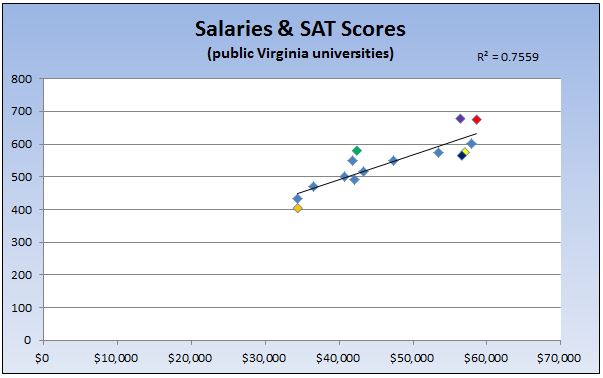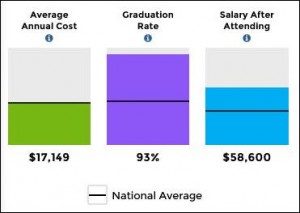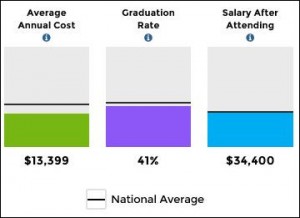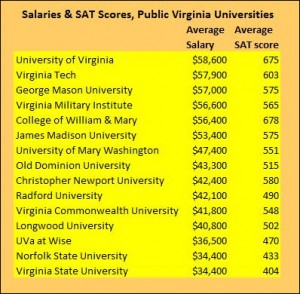by James A. Bacon
The U.S. Department of Education has published a new online College Scoreboard, which provides useful data for anyone thinking about where to attend college — and for anyone such as citizens, alumni and legislators who wish to appraise the quality of education provided by each institution.
The searchable data provides statistical profiles of virtually every higher educational institution in Virginia and the country — from the University of Virginia to the Art Institute of Washington-Dulles. The tool is a wonk’s dream, providing all sorts of ways to slice and dice the data.
To provide an example, I have highlighted above my alma mater, the University of Virginia. The average cost of attendance, at $17,149, is right at the national average. But the graduation rate is far higher, among the very highest in the country, and the average salary of graduates is significantly higher.
The database allows us to drill deeper to find, for example, that 95% of UVa graduates are paying down their debt, compared to 67% nationally, 24% receive federal loans and, of those who do, they average $19,500 indebtedness upon graduation. The profile breaks down the student body by race/ethnicity and provides the range of SAT scores as well.
At the other end of the scale is Virginia State University, the seeming sad sack of Virginia’s public university system, where the graduation rate is a meager 41%, and the post-graduation salary $24,000 less than at UVa. Eighty-five percent of all VSU students receive federal loans and, despite a lower tuition than UVa, they average $28,451 in total debt. With such a high debt load, no wonder only 47% are paying down their debt.
That’s not necessarily to say that VSU as a institution is doing a bad job. Clearly, VSU is serving a very different demographic than UVa — predominantly African-American with lower SAT and ACT scores in contrast to UVa’s predominantly white/Asian student body with high SAT and ACT scores. UVa looks good by many measures because it selects the academic cream of the crop of all races/ethnicities, while VSU provides a higher ed option to students who might not be able to attend college anywhere else.
I was curious: Does the superior salary performance of UVa students reflect anything more than the selectivity of the student body? All other things being equal, one would expect smarter students to get higher-paying jobs in America’s knowledge economy than less academically proficient students. Is UVa providing real educational value added, or is it just using its prestige to recruit smarter students?
As a first stab at answering that question I ran a scatter chart correlating average SAT scores with average salary for each public institution. (The College Scoreboard database does not provide average SAT scores, but it does provide SAT ranges for reading, math and writing, so I averaged the high and low of the ranges for each.) The result:

Negative outliers (above the line): Green, CNU; Purple, W&M; red, UVa. Positive outliers: orange, VSU; dark blue, VMI; yellow, GMU. Click for bigger image.
Here is the raw data that goes into that chart:
The R² for the slope suggests that 75.6% of the variation in salary can be attributed to SAT scores. Clearly, student selectivity is the dominant explanation for the variation in salaries. But it’s not the only explanation. The other 24.4% can be explained by other factors such as the quality of the educational experience, the value of the alumni network or other factors. Institutions below the trend line exhibit a higher pay/SAT ratio, while those above exhibit a lower pay/SAT ratio.
Thus, we see that VMI students slightly outperform W&M students in average salary even though W&M students average SAT scores 113 points higher! ODU students outperform Christopher Newport students in average salary by $900 per year, even though CNU students’ SAT average SAT scores are 65 points higher. As for poor, sad sack VSU, well, its average salary actually performs on the positive side of the trend line given the SAT scores of its students.
Please regard these numbers as no more than a starting point for analysis. Average salary is only one way of measuring the value of an education. Older universities which have larger and richer alumni networks and bigger endowments enjoy a big advantage over newer institutions with younger, less affluent alumni. Institutions with graduate schools in law, business and medicine can be expected to have higher-income graduates as well. None of these numbers are definitive. What I have tried to do is show the kind of analysis that can be accomplished with the data, providing grist for legislators and boards of visitors to hold the managements of the schools accountable. For sure, university administrations will never present this kind of analysis.
For another example of how the data can be used, check out John Butcher’s spin on Cranksyblog. As always, my offer stands: Conduct your own analysis and email it to me at jabacon[at]dev.baconsrebellion.com. I’ll consider it for publication on the blog.





